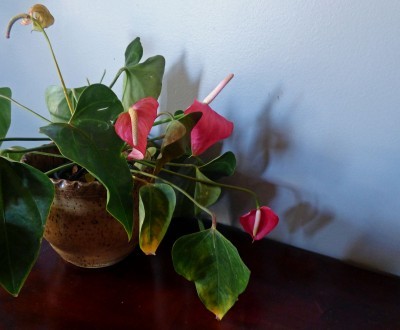






Anthuriums are from South American rainforests and the tropical beauties you see in Hawaiian gift stores and airport kiosks. They are members of the Arum family and produce bright red characteristic spathes that are often mistaken for flowers. The thick glossy leaves are a perfect foil for the spathes. These common houseplants are perfect for middle light areas and high humidity zones in the household.
Anthuriums are often grown on a piece of lava rock or bark because they are epiphytic and produce long aerial roots to attach to surfaces. They are relatively disease and pest free but are fussy about humidity and moisture. A droopy anthurium could have water issues, lighting problems or a rare case of blight. Find out the answers to why an anthurium with drooping leaves is doing poorly and save your tropical prized plant.
To fully answer the question, “why is my anthurium droopy,” you need to understand the plant’s needs. As tropical understory plants, they thrive in dappled to medium light. They often reside in trees but may also be found on the forest floor.
The plants grow best with daytime temperatures of 78 to 90 degrees Fahrenheit (25 to 32 C) but average indoor temperatures are usually sufficient. They need to be warm at night too, with averages between 70 and 75 F. or 21 to 23 C. If they are outdoors and experience temperatures below 50 degrees Fahrenheit (10 C), they will begin to suffer and the leaves will yellow and droop.
An anthurium with drooping leaves may also be experiencing a water, lighting or disease issue.
Anthurium plant drooping may be caused by other conditions. If the plant is near a heater where dry air is produced, it will experience too little humidity. These epiphytes need 80 to 100 % humidity.
If the plant is in poorly draining soil, it will show signs of browning on the leaf tips and drooping foliage. Conversely, the drooping with yellow tips may be a sign of too little water. Use a soil moisture meter to be certain the plant is evenly moist but not soggy.
Disease problems, like root blight, are common and can make the leaves sag and stems bow. Replace the soil and wash the roots in a .05% solution of bleach. Wash out the container with the bleach solution before replanting.
Always water deeply to flush the soil of fertilizer salts and toxic minerals and then allow the surface of the soil to dry before watering again.
Mites and thrips are the most common pests of anthurium. They can be dealt with by rinsing the insects off the leaves of the plant. In severe infestations, you can apply a horticultural oil or soap on a regular basis to kill the insects. These sucking pests cause leaf damage through their feeding behavior. On occasion, aphids and other insects might attack the plant, but these cases are rare.
Start with a visual inspection of the plant and then proceed to evaluate your cultivation methods if your inspection turns up no insects. Droopy anthuriums are generally the result of some cultural error and can be fixed easily once you identify the cause.
Provided you have high humidity, medium indirect light and frequent watering with good soil leaching, your plant should produce the lovely spathes on an annual basis.
Copyright © www.100flowers.win Botanic Garden All Rights Reserved